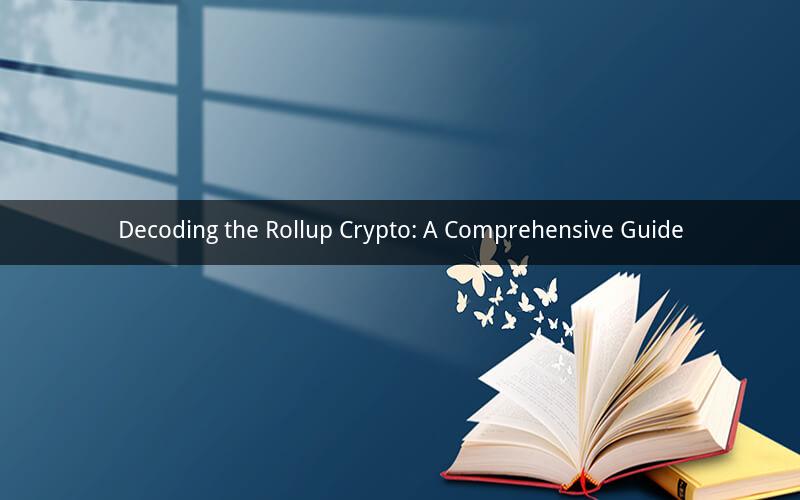
Introduction:
In the ever-evolving world of cryptocurrencies, the concept of rollups has emerged as a transformative innovation. This article aims to provide an in-depth understanding of what a rollup crypto is, its significance, and how it differs from traditional blockchains. We will explore the working mechanism, advantages, and challenges associated with rollups, followed by a Q&A section to address common queries.
Section 1: Understanding Rollups
What is a Rollup Crypto?
A rollup crypto is a technology that enables the integration of multiple blockchains into a single, more efficient and scalable network. By combining transactions from various blockchains, rollups aim to address the limitations of existing blockchain systems, such as high transaction fees and limited scalability.
How do Rollups Work?
Rollups operate by bundling multiple transactions from different blockchains into a single transaction called a "bundle." This bundle is then submitted to a parent chain, typically an Ethereum-based blockchain. The parent chain validates the bundle and adds it to its own ledger, ensuring the integrity and security of all transactions included in the bundle.
Types of Rollups
There are two main types of rollups: Optimistic rollups and ZK rollups. Optimistic rollups assume that all transactions are valid by default and rely on fraud proofs to challenge invalid transactions. ZK rollups, on the other hand, use zero-knowledge proofs to validate transactions, ensuring higher security and scalability.
Section 2: Advantages of Rollups
Scalability:
One of the primary advantages of rollups is their ability to enhance scalability. By aggregating transactions from multiple blockchains, rollups can process a significantly higher number of transactions per second compared to traditional blockchains, thus reducing congestion and lowering transaction fees.
Security:
Rollups leverage the security of the underlying parent chain, providing a robust and reliable framework for transaction validation. The use of fraud proofs or zero-knowledge proofs further enhances the security of rollups, making them resistant to various types of attacks.
Cost Efficiency:
By reducing the number of transactions directly on the parent chain, rollups can significantly lower transaction fees. This makes rollups an attractive option for users who seek cost-effective solutions for sending and receiving cryptocurrencies.
Interoperability:
Rollups facilitate interoperability between different blockchains. By aggregating transactions from various blockchains, rollups enable seamless communication and collaboration between different networks, fostering a more interconnected crypto ecosystem.
Section 3: Challenges and Limitations
Rollup Scalability:
While rollups offer enhanced scalability, the process of aggregating transactions from multiple blockchains can still be resource-intensive. The scalability of rollups largely depends on the underlying parent chain's capabilities and limitations.
Security Concerns:
Although rollups aim to provide enhanced security, the reliance on fraud proofs or zero-knowledge proofs introduces potential vulnerabilities. Ensuring the accuracy and reliability of these proofs remains a significant challenge for the rollup ecosystem.
Rollup Implementation:
Implementing rollups requires collaboration between different blockchains and development teams. Achieving consensus and integrating rollups into existing networks can be complex and time-consuming.
Regulatory Hurdles:
The regulatory landscape surrounding cryptocurrencies is continuously evolving. Rollups may face challenges in adhering to evolving regulations and ensuring compliance across different jurisdictions.
Section 4: Rollup Crypto Examples
Ethereum-based Rollups:
Several Ethereum-based rollups have gained popularity, including Arbitrum, Optimism, and zkRollups. These rollups leverage the Ethereum network's infrastructure to enhance scalability and reduce transaction fees.
Cross-chain Rollups:
Cross-chain rollups aim to bridge the gap between different blockchains, enabling seamless communication and interoperability. Examples include Polkadot-based rollups and Cosmos-based rollups.
Section 5: Q&A
Question 1: What is the difference between a rollup and a sidechain?
Answer: A rollup integrates multiple blockchains into a single network, while a sidechain operates as a separate blockchain parallel to the main chain. Rollups enhance scalability and security within the parent chain, while sidechains provide additional functionality and flexibility.
Question 2: Can rollups solve the scalability issues faced by traditional blockchains?
Answer: Yes, rollups can significantly enhance scalability by aggregating transactions from multiple blockchains. This allows for a higher number of transactions per second and reduces congestion and transaction fees.
Question 3: Are rollups more secure than traditional blockchains?
Answer: Rollups aim to provide enhanced security by leveraging the security of the underlying parent chain and utilizing fraud proofs or zero-knowledge proofs. However, security remains a complex challenge, and rollups are not immune to potential vulnerabilities.
Question 4: Can rollups coexist with traditional blockchains?
Answer: Yes, rollups can coexist with traditional blockchains. In fact, rollups can complement traditional blockchains by addressing their scalability and cost limitations, fostering a more efficient and interconnected crypto ecosystem.
Question 5: What is the future of rollup crypto?
Answer: The future of rollup crypto looks promising. As the technology matures and gains wider adoption, rollups are expected to play a crucial role in addressing the scalability and security challenges faced by existing blockchain systems. Collaboration between different blockchains and continuous innovation will drive the advancement of rollup technology.